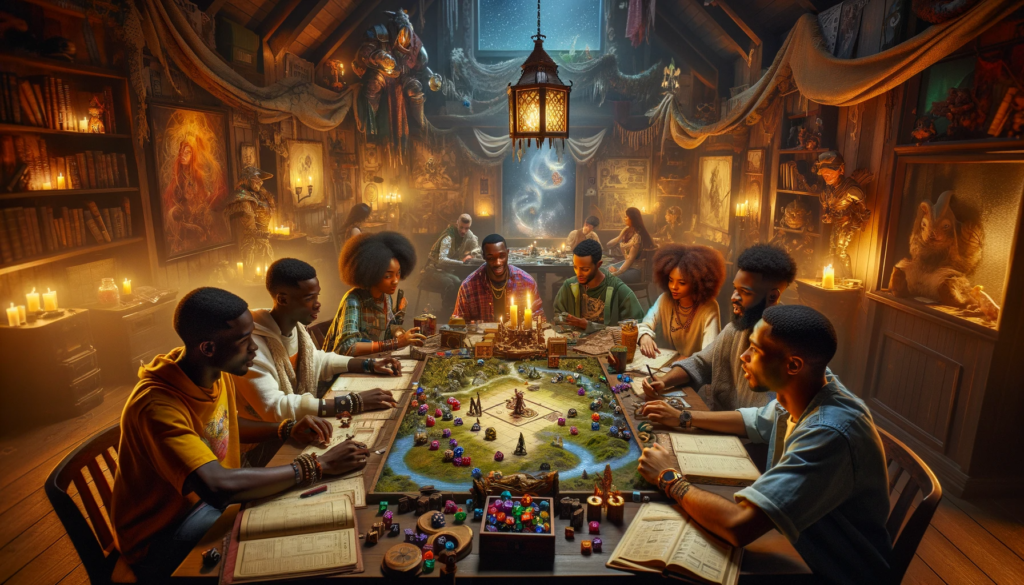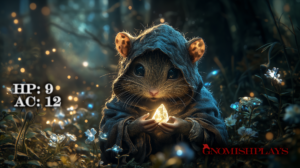World-building is a crucial element of immersive gaming in Tabletop role-playing games (RPGs), It’s a process that involves more than just setting the stage for your adventures; it’s about creating a dynamic, immersive gaming environment that breathes life into your campaigns. Every detail contributes to a compelling narrative, from the intricate histories and cultures to diverse landscapes and creatures. In this article, we’ll review several tools and tips newcomers and seasoned creators can use to add immersion to their campaigns with world-building.
The Importance of World Building in RPGs
World-building serves as the foundation for your tabletop RPG campaigns. It sets the tone, establishes the rules, and provides context for the characters’ actions. Without a well-crafted world, the game can feel flat and uninspiring. But with a richly detailed setting, every quest, encounter, and decision becomes part of a larger, more meaningful story.
Your RPG world creation process should enhance the gaming experience and encourage creative problem-solving, strategic planning, and collaborative storytelling. It allows players to fully engage with the game, fostering a sense of immersion and investment in their characters’ fates.
Key Elements of Interactive RPG World Building
Whether you’re a dungeon master or a homebrew game creator, building an immersive and interactive world is key to creating a memorable, immersive gaming experience for your players.
Creating a Cohesive and Believable World
First and foremost, a believable world must be cohesive. The geography, history, culture, and even the laws of physics need to make sense within the context of the world. For instance, in Dungeons & Dragons (D&D), the Forgotten Realms setting is a high fantasy world with its unique pantheon, magic system, and history that all cohesively work together.
To create a cohesive world:
- Begin with a broad overview.
- Decide on the type of world (fantasy, sci-fi, post-apocalyptic, etc.), then gradually flesh out details like geography, history, and culture.
- Consistency is key — every new detail should fit logically within the established world.
Developing Engaging Non-Player Characters (NPCs)
NPCs breathe life into your world. They can be allies, enemies, or neutral parties, but regardless of their role, they should feel real and complex. Consider what motivates your NPCs, their backgrounds, and their personalities.
For example, in Critical Role, Dungeon Master Matthew Mercer’s character Pumat Sol is not just a shopkeeper; he’s a friendly firbolg with a love for enchanting and a unique speech pattern. This level of detail makes interactions with Pumat Sol engaging and memorable.
Creating Compelling Quest Lines
A compelling quest line can turn a good RPG into an unforgettable one. Quests should challenge players to make tough decisions and think strategically. Look to games like Pathfinder for inspiration, where quests often have multiple solutions, encouraging creativity from players.
Quests should also tie into the larger narrative and world. This deepens immersion and gives players a sense of impact — their actions are changing their world.
Providing Player Choice and Impact
Player agency is a cornerstone of tabletop RPGs. The decisions players make should have tangible effects on the world. This reinforces the feeling that they’re not just playing a game but living in a different reality.
For example, players’ decisions can lead to a town being saved or destroyed, impacting the physical landscape and their relationships with NPCs.
World Building Across Different RPG Systems
RPG systems are frameworks that guide the mechanics of role-playing games. Examples include D&D, Pathfinder, and Call of Cthulhu, each with unique rules and settings. However, regardless of the system, world-building remains a fundamental part of creating an immersive RPG experience.
Unique World-Building Elements
While there are shared elements, each RPG system also has unique aspects that set them apart:
- D&D: Known for its high fantasy settings, D&D often features elaborate magic systems and mythical creatures. The world-building in D&D is about creating a sense of wonder and adventure.
- Pathfinder: Similar to D&D, Pathfinder distinguishes itself by emphasizing a singular, highly detailed world – Golarion. It offers a rich tapestry of diverse cultures and exotic locales for GMs to explore.
- Call of Cthulhu: This RPG is based on H.P. Lovecraft’s cosmic horror stories. Its world-building involves creating a sense of dread and insignificance in the face of ancient, powerful entities.
Tips for World-Building Across Different Systems
- Understand the System: Each RPG system has its unique flavor. Understand what makes the system unique and build your world to complement it.
- Start Small: Begin with a single city or region and gradually expand. This can help prevent becoming overwhelmed by the scale of a whole world.
- Involve Your Players: Make your players feel invested in the world. Incorporate their backstories and give them opportunities to influence the world.
Despite these differences, the fundamental principles of world-building remain the same. Regardless of the system, a well-defined setting enhances the gaming experience and facilitates engaging storytelling.
Integrating World Building with Game Mechanics in Tabletop RPGs

Nothing compares to the thrill of creating an entirely new world from scratch. The art of world-building — crafting intricate landscapes, cultures, histories, and societies — is a cornerstone of any RPG. But how can we seamlessly integrate this world-building process with game mechanics for a truly immersive experience?
Making Game Mechanics Matter
To intertwine game mechanics with your world, begin by considering the core themes of your setting. Is it a high-fantasy world filled with magic and mythical creatures? If so, incorporating mechanics that involve spellcasting or creature encounters will reinforce your world’s theme.
In a more political and intrigue-driven world, mechanics focusing on social interactions, alliances, and deception can bolster the narrative. The key here is to ensure that your game mechanics aren’t just arbitrary rules but are deeply rooted in the world you’ve built.
Building the World Through Mechanics
Conversely, game mechanics can also guide your world-building process. Let’s say you’ve developed a unique combat system involving elemental powers. This mechanic can influence the creation of various factions or cultures in your world, each associated with a specific element.
Similarly, if your RPG involves a detailed crafting system, you might build a world rich in diverse materials and resources. Thus, the symbiotic relationship between world-building and game mechanics can make your RPG more engaging and consistent.
Player Interaction: The Crucial Link
The final, crucial aspect of integrating world-building with game mechanics is player interaction. Players should feel that their actions, governed by the game’s mechanics, have a tangible impact on the world.
For instance, if players successfully lead a rebellion in a city, the political landscape should change, reflecting their victory. This dynamic interaction makes players feel invested in your world and reinforces the link between your world and its mechanics.
Merging world-building and game mechanics in tabletop RPGs is a process that takes time. It’s an exciting dance, a back-and-forth where one influences the other, creating a cycle of creativity. By intertwining world-building and game mechanics, you can create a rich, immersive experience that lures players into your world and keeps them eagerly coming back for more.
The Top Tools for World Building
World-building involves crafting intricate histories, diverse cultures, unique landscapes, and many creatures. It’s what makes each gaming experience distinct and immersive. Given its significance, it’s no surprise that several tools are designed to assist game masters in this creative endeavor.
World Anvil
World Anvil is a comprehensive world-building platform that caters to various creators, from authors and game masters to hobbyists. It provides a robust set of tools designed to facilitate the creation of immersive and detailed worlds. World Anvil has something to offer, whether you’re crafting a high fantasy realm or a futuristic sci-fi universe.
Features and Limitations
World Anvil allows you to organize your world’s lore in a structured and visually appealing manner. It offers over 25 templates to guide you through world-building, covering everything from geography and history to races and magic systems.
The platform also enables you to embed maps and images into your articles, visually representing your world. The interactive map feature is particularly notable, allowing you to create pins linked to articles about specific locations.
One of World Anvil’s standout features is its community aspect. Users can publish their worlds publicly and share them with the World Anvil community, fostering a sense of camaraderie among world builders.
World Anvil’s interactive map feature and the ability to link related articles are particularly useful for visualizing your world and its complexities. However, World Anvil does have a learning curve. New users might find the interface overwhelming due to the sheer number of features and options. It’s also worth noting that while World Anvil offers a free version, some of the more advanced features require a paid subscription.
Inkarnate
Inkarnate is a web-based tool for RPG enthusiasts and fantasy authors looking to bring their worlds to life with custom maps. Boasting various features and considered one of the best fantasy map making tools, this program provides an intuitive platform for creating detailed and visually impressive maps.
Features and Limitations
Inkarnate offers a wide range of tools and assets that differentiate it from other world-building programs. It includes a vast library of high-quality textures and objects, allowing users to create varied and richly-detailed environments. From forests and mountains to buildings and landmarks, Inkarnate caters to all your cartographic needs.
The program also allows for the design of intricate floor plans complete with furniture and other details. Despite its many strengths, Inkarnate does have some limitations. While it excels at creating individual maps, it lacks features for world-building on a larger scale, such as lore management or character tracking. Additionally, the free software version offers limited assets, which can restrict your creativity. To access the full range of assets, a pro subscription is required.
LegendKeeper
In world-building, LegendKeeper is rapidly making a name for itself. This innovative tool streamlines the creative process, enabling writers and game developers to construct detailed fictional universes easily.
Features and Limitations
LegendKeeper is designed as a creative writing tool and world-building reference. It serves as an excellent companion at the writing desk or game table. The software’s primary focus is to enhance your creative flow rather than overwhelming you with endless forms.One of LegendKeeper’s standout features is its rapid creation tools. The software includes options such as Create Page, @-mentions, Cut-to-New-Page, Page Templates, and Auto-linking, all of which contribute to creating worlds at the speed of thought.
The platform also includes a lightweight wiki with gaming-specific features and quality-of-life enhancements. This allows users to keep track of their world’s lore in an organized manner.
Another notable feature is LegendKeeper’s strong atlas system. This interactive mapping feature enables users to visualize their world geographically, adding another layer of depth to their creations.
A Step-by-Step Guide to World Building with Inkarnate, LegendKeeper, and World Anvil
With the advent of digital tools such as Inkarnate, LegendKeeper, and World Anvil, creating intricate, immersive worlds has never been easier.
Here’s a step-by-step guide on how to use these powerful tools to bring your world to life.
Step 1: Conceptualize Your World
Before you dive into any tool, begin with brainstorming. Consider the type of world you want to create. Is it a sprawling fantasy kingdom, a distant sci-fi galaxy, or perhaps a post-apocalyptic wasteland? Jot down the key elements of your world: its geography, climate, cultures, races, religions, and history.
Step 2: Start Mapping with Inkarnate
Inkarnate is a robust map-making tool perfect for visualizing your world’s geography. Begin by choosing a template that matches your world’s environment. You can select from various templates, like continents, islands, or cityscapes.
Next, use Inkarnate’s vast library of assets to flesh out your map. Add mountains, forests, rivers, or cities. Remember, your map should reflect the climate and geography you envisioned during your brainstorming session.
Step 3: Deepen Your Lore with LegendKeeper
After mapping out your world, it’s time to delve into its lore. LegendKeeper allows you to attach information to specific locations on your map, making it an excellent tool for detailing your world’s history, culture, and notable locations.
Upload your Inkarnate map to LegendKeeper. Then, start adding ‘pins’ to your map. Each pin can contain text, images, or even links. Use these pins to elaborate on your world’s lore. For example, you can detail a city’s history, describe a village’s customs, or explain the significance of a mountain range.
Step 4: Create and Organize with World Anvil
World Anvil is an all-encompassing world-building tool that allows you to create and organize every aspect of your world. After you’ve laid out the geography and lore, use World Anvil to flesh out finer details.
Start by creating articles for each element of your world. These could include characters, species, items, or events. World Anvil’s templates guide you through this process, prompting you to consider aspects you might otherwise overlook.
Next, link these articles together to create a web of interconnected information. This feature helps establish relationships between different elements of your world, adding depth and realism.
Finally, upload your map from LegendKeeper to World Anvil, and tie your articles directly to locations on the map. This feature combines your geographical, historical, and cultural information in one place, providing a comprehensive overview of your world.
Step 5: Refine and Expand
Now that you’ve built a solid foundation, continue refining and expanding your world. You’ll inevitably develop new ideas as you write stories or run games in your world. Add these to your world, using Inkarnate, LegendKeeper, and World Anvil to keep everything organized and coherent.
Beyond Mechanics and Statistics
World-building for tabletop RPGs goes beyond mechanics and statistics. It’s about creating a living, breathing world filled with endless possibilities. It’s an opportunity to let your imagination run wild, crafting unique cultures, intricate histories, and stunning landscapes.
You can transform your campaigns from mere games into unforgettable adventures by putting effort into world-building. You create a space where epic tales unfold, heroes rise, and legends are born. So, pick up that pen, grab your dice, and start building a world you and your players will love exploring.


